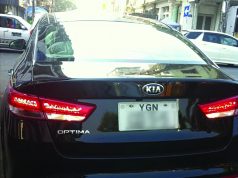As you drive from the Mingladon airport in Yangon down Pyay Road towards the heart of the city, it is refreshing to see large, glittering auto show- rooms lining both sides of the broad road. These include not just the Mercedes Benz sales and service outlet and the Tata Motors showroom, but many of the 200-plus used car outlets that have opened in Yangon, a majority of them after 2011.
The automotive sector is a buzz with activity, especially on the retail front. Korea’s Hyun- dai opened its first sales showroom in august 2013 with plans to open another 13 in the next five years, all over Myanmar. America’s Ford Motor Company entered Yangon with its first dealership in August 2013, and Gen- eral Motors followed an outlet exclusively for its Chevrolet brand. Japan’s leading car maker, Toyota opened its first showroom in March 2014 in partnership with a local com- pany, though the first Toyota service center has been operational since 1996, the second one having opened in 2013. Mazda, again a Japanese car brand, is operating out of a tem- porary store for the present trying to capture a slice of the burgeoning auto demand. Mer- cedes cars zipped on Yangon roads for long, but the first showroom was formally opened in May 2014, after operating out of a small temporary set up since November 2013. The newest to open is the famous UK brand, Jag- uar Land Rover, now owned by India’s Tata Motors that has tied up with the local Capital Diamond Star Group.
On the manufacturing front, Suzuki is set to resume production at its shuttered facil- ity, with fresh government approval. Nissan has stated that it will start manufacturing its model, Sunny, in Myanmar in 2015, and is constructing an 80-acre industrial complex in partnership with the local Tan Chong Group. The Malaysian spare parts manufac- turer, APM Automotive Holdings, also plans to open a spare parts manufacturing unit in Myanmar to meet the spiraling demand for spares. Not ones to be left behind, Chi- nese auto manufacturers feel the auto mar- ket might be in its nascent stages, but large enough for them to make a place for them- selves as well, with their Beijing Automotive Industry Holdings Company and Dong Feng Motor Group starting operations in January and February respectively.
Seeing this easy availability of latest models of some the world’s best cars, it is a little dif- ficult to fathom why the cars on the road, still belong to a seemingly different age, a signif- icant percentage of which are decades old. Long sedans of a bygone era, mainly in black and white, form long queues on roads as the number of cars multiplies, steadily worsen- ing road traffic. 95% of the cars on the road are used vehicles and at least 80% of these are imported from Japan, from the small and compact Belta, to the pre-2006 domes- tic version of Lexus, namely the Celsior. A significant numbers of these have replaced the rusted, dated British era vehicles that stayed in moving condition with repeated re- conditioning, since importing newer models was once unaffordable. High import duties and levels of taxation, made Myanmar one of the most expensive countries to own cars.
Old wheels
Only three years ago, owning a car by major- ity of the Myanmar populace was a dream, since this was the prerogative of a select few, given the steep import duties and regulations against car imports in a country that has vir- tually no local manufacturing of consumer durables, leave alone automotives. However, the situation improved, when in 2011, a quasi civilian government took over, opened up the country, eased imports, reduced tax rates, and has since, changed import regula- tions eight times!
Under military rule, there were stiff import restrictions on automobile imports, partly to prevent outflow of precious foreign ex- change. New vehicles could be imported only by a very small section of the elite, including military personnel. The rest had to buy used cars imported from countries like Japan, and sold through numerous used car sales centers. Foreign auto makers had a presence only to offer maintenance services. Japanese cars have always had an edge in Myanmar, and enjoyed something of a ‘most preferred status’, due to their superiority in terms of quality and design, and easy availability of spares.
This explains the presence of 20-40 years old cars on the roads, reconditioned to remain operational and moving. In 2011, import re- strictions were eased, and this helped write off some of the oldest vehicles and newer models were permitted to be imported in exchange.
Demand unleashed
Auto manufacturers from across the globe are eyeing the potential demand unleashed by 60 million people as they discover tech- nological innovations and catch up with the rest of the world. According to a KPMG report on Myanmar’s infrastructure, as of now, the country’s transport sector is gross- ly underdeveloped keeping in mind its size, population and potential. While neighboring Thailand had 432 vehicles per 1000 people in 2011, and Laos 171, Myanmar had only 38, even though the number of vehicles in- creased two and a half times between 2004 -2011. Myanmar also happened to be one of the world’s most expensive countries for cars.
The latest easing of rules in October 2013 have made it possible for local companies to import new vehicles, but with an inventory capping of 100 vehicles. This has served as a green signal for foreign car manufacturers to eye this potential behemoth in terms of demand, and the market still in its nascent stages, promises room for growth to multiple entrants. While Japan may continue leading, the Chinese are anxious to make their pres- ence felt as well, besides other countries including India, Korea, Malaysia, Germany and America.
One crucial factor that explains this demand is a growing middle class. In a country where the middle segment of society was miniscule, demand can now be seen growing unmistak- ably as it is these consumers who have rel- atively higher spending capability. They are the ones to opt for better cars not merely for their brand value. It is this middle segment that is always targeted by manufacturers wanting to boost sales.
The statistics made available by the road transport administration show the steady demand for vehicles with over 70,000 cars being imported under the substitution pro- gram of over aged cars and over 100,000 new cars for showrooms, military, tourism purposes and private ownership, between October 2011 and May 2013. The twelve month period ending December 2013 saw a 30% increase over the previous year, in the registration of 400,000 passenger cars. Predictions for 2014 indicate a 15% jump in demand for cars.
Substitution of over aged cars is a post 2011 phenomenon and in the 11-month period between September 2011 and July 2012, 60,000 cars were retired and scrapped. This explains the quick disappearance of the most dated, rusted and run down vehicles from the roads that posed safety risks.
The numbers apart, sales personnel of the newly opened showrooms are amazed at the number of prospective customers walking in, far beyond their expectations. Small cars re- main the best selling due to their affordabili- ty by a population that has a per capita GDP of USD 1400 (2013).
This boom in the auto market in Myanmar, is one of the first signs of an economy on a rapid growth path, that will spur growth in related sectors. As predicted by Frost & Sullivan, the real period of growth has only now begun with compounded annual growth rates in the automotive sector touching 7.8% between 2012 -2019.
Yangon is one city that does not permit two wheelers, the most popular medium of transport for the lower and middle strata of society. This necessitates an investment in used cars that would cost an approximate equivalent, or else rely on public transport. In the next couple of years, demand for vehi- cles is likely to be from tier-II cities, as much as from large ones.
The need of the hour
Going by the surge in the number of cars, the ensuing traffic jams especially in bigger cities like Yangon and Mandalay, are only to be expected. But the long queues at traf- fic signals and endless waiting periods also reflect the urgency with which infrastructure needs to be developed. The road network is decades old and cannot handle the increased numbers. New roads, flyovers and bypass routes are the need of the hour, and soon, before the road jams become unmanageable.
There is a vast market for vehicles, but not everyone savings to make a down payment and drive off. In a country where the banking system is undergoing change, foreign players coming in, access to credit for buying vehicles would be so welcome. A few banks have already pitched in. For instance, the Ayeyarwady Bank offers credit of up to 50% for Mercedes Benz cars, repayable in 1-5 years, after customer percent of the price.
Service and Spares
Almost all the newly opened showrooms offer sales, service and spares, facilitating maintenance with original spare parts. Less than four years ago, keeping decades-old cars running, was a technological marvel, with ingenious innovations being made each time the reconditioned cars stalled. Ancil- lary industries are the next step to feed the auto industry. According to the McKinsey Report on Myanmar, automotive parts and assembly figure high on the list of industries with high growth potential and high levels of productivity. This will give an impetus to de- mand for skilled labor that is almost missing at present.
As developed nations struggle with lower de- mand and seek ways to boost it to prevent their economies from slowing down, Myan- mar is one Asian nation that shows promise of unprecedented demand, all of it set to benefit foreign auto manufactures , since the country and its entrepreneurs have yet to dream of an indigenous Myanmar car.










